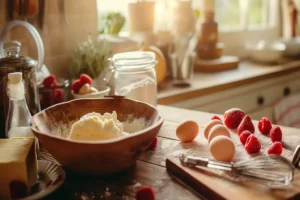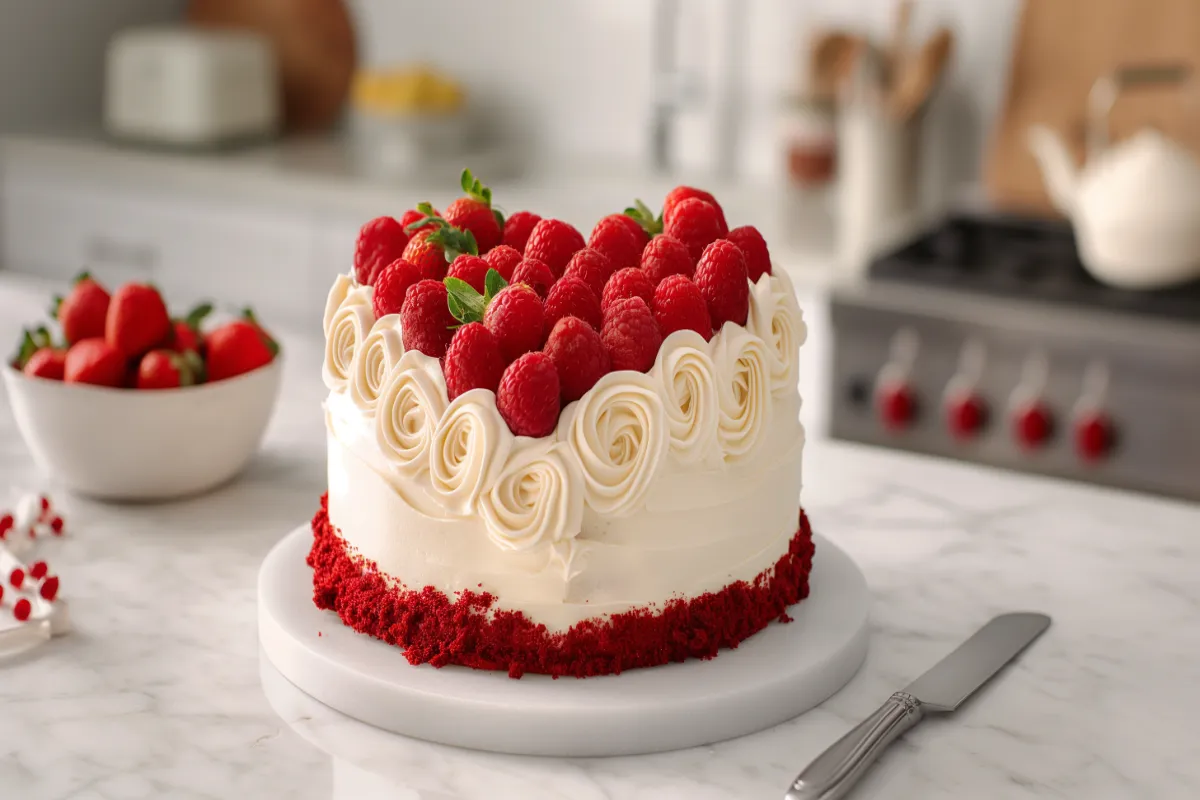Heart cakes are a beautiful and symbolic choice for various celebrations, symbolizing love, care, and affection. Whether you’re making a heart cake for Valentine’s Day, an anniversary, a wedding, or simply as a sweet surprise, this guide will help you create the perfect cake. We’ll walk you through the history of heart cakes, step-by-step instructions on how to bake, shape, and decorate, as well as creative flavor ideas, decorating tips, and occasion-specific inspiration to ensure your heart cake is a stunning centerpiece.
Introduction to Heart Cakes
A heart cake is a cake shaped like a heart, often symbolizing love and romance. These cakes are extremely popular for romantic events, including Valentine’s Day, anniversaries, and weddings. However, they can also be a fun way to personalize a birthday or even show appreciation for someone special. Whether covered in buttercream or adorned with fondant, a heart cake is always a sweet treat to share.
The tradition of heart-shaped cakes likely stems from the long-standing association of the heart shape with love and affection. Across many cultures, the heart is seen as the symbol of love, making it a natural choice for celebratory cakes during romantic or affectionate events.
If you don’t have a heart-shaped pan, don’t worry! You can shape cakes without a special mold using a round and square pan. Learn how by checking out this simple guide from Taste of Home.
For those interested in adding more intricate touches, you can gain inspiration from different textures used in other dessert types, such as the Red Velvet Brownies Recipe, where combining different techniques produces unique outcomes.
The History of Heart Cakes
Heart-shaped cakes have long been associated with love, dating back to medieval times. The heart symbol, which represents affection and emotion, eventually found its way into food, and over time, heart cakes became popular for romantic celebrations. The heart shape has been used not just in cakes but in candies, cards, and other romantic gestures.
The modern heart cake, with its soft, rounded edges and sweet frosting, became more mainstream in the 20th century as baking techniques evolved. Heart cakes became a staple at Valentine’s Day celebrations, particularly in North America, where the day of love often includes sweet treats. Additionally, heart cakes gained popularity in weddings, symbolizing love and unity.
Their evolution has led to a wide variety of heart cakes, from vintage-style cakes to modern fondant-covered designs. For example, if you’re curious about different types of cake textures, you might also want to check out What Makes Brownies Fudgy or Cakey, which explores how simple adjustments can change the outcome of your baked goods. These techniques can be applied to heart cakes to achieve your desired texture and flavor.
Different Types of Heart Cakes
Traditional Heart Cakes
- Buttercream Heart Cakes: These classic cakes feature rich buttercream frosting and are often decorated with simple piping or sprinkles. Buttercream heart cakes are a great choice for beginners as they are easy to frost and decorate. Buttercream’s versatility allows you to create anything from a smooth, clean look to more intricate piping work.
- Fondant Heart Cakes: For a sleek, polished finish, fondant-covered cakes are often used for formal events like weddings. Fondant allows for intricate designs and a smooth finish, making it ideal for cakes that require a refined look. Fondant can also be dyed into various colors, so you can match it to your event’s theme.
Vintage Heart Cakes
Vintage-style cakes are making a comeback, with their pastel colors and intricate designs. These cakes often feature elaborate piping, floral decorations, and classic touches reminiscent of 1950s desserts. The charming aesthetics of vintage cakes bring a sense of nostalgia and romance. Whether you’re decorating with buttercream rosettes or piping detailed lace patterns, vintage heart cakes are perfect for those who want to add a sentimental touch to their dessert table.
These cakes are popular at weddings, baby showers, and other celebrations where a touch of elegance is desired. Creating these cakes requires a steady hand for piping and an eye for design, but the result is a beautifully nostalgic cake.
Vegan and Gluten-Free Heart Cakes
As dietary preferences shift, many people are seeking out vegan and gluten-free options. Vegan heart cakes can be just as indulgent and delicious as traditional cakes, often using alternative ingredients like almond flour, coconut oil, and plant-based milk.
Gluten-free heart cakes are also becoming more common as awareness of gluten sensitivities grows. Gluten-free flours such as rice flour, almond flour, and coconut flour can be used to create a light and fluffy cake without sacrificing flavor or texture. Vegan and gluten-free cakes can also be paired with dairy-free frostings like coconut cream or vegan buttercream, offering a wide range of creative options for those with dietary restrictions.
Decorating Ideas for Heart Cakes
Simple Buttercream Designs
If you’re new to decorating, starting with buttercream is ideal. Use a simple frosting technique to cover the cake, then add small embellishments like flowers, sprinkles, or piped designs. Buttercream is easy to work with, and a few simple touches can make your heart cake look stunning without needing advanced decorating skills. Use contrasting colors for added visual appeal, like a pale pink frosting with red or white sprinkles.
Buttercream cakes can also be easily personalized. If it’s a birthday heart cake, use bright colors and playful decorations, or keep it classic with red and pink for a Valentine’s Day cake.
Advanced Piping and Fondant Work
For those with more experience, adding details with fondant or piping can elevate your cake’s design. Use fondant to create smooth finishes, ribbons, or edible flowers. Fondant provides a flawless surface for more intricate work, including hand-painted details, stenciling, or draped fondant ribbons.
If you prefer piping, intricate patterns such as lace designs or delicate flowers can turn your cake into a masterpiece. Advanced techniques like royal icing piping or gum paste flowers can add depth and texture to your cake. These techniques require practice but produce stunning results.
For additional ideas and tips on decorating techniques, you can explore posts like the Red Velvet Cookie Cake, which features creative and fun ways to use frosting and toppings.
Personalized Decorations
- Add edible toppers with custom messages or names.
- Use fresh or edible flowers for a natural, elegant look.
- Tailor the design to the occasion (e.g., Valentine’s Day, anniversaries, birthdays).
Personalized heart cakes are always a hit because they show extra thought and care in the design process. For weddings or anniversaries, consider adding edible gold leaf, delicate sugar pearls, or fondant bows to make the cake truly special.
Step-by-Step Guide to Making a Heart Cake

1. Choose Your Recipe
First, decide what type of cake you want to bake. Traditional options like chocolate, vanilla, and red velvet are crowd-pleasers, but you can also experiment with flavors like lemon, strawberry, or even salted caramel. For a festive twist, you might even consider flavoring the frosting or adding fruit fillings like raspberry or passion fruit.
2. Baking the Cake
Once you’ve picked your recipe, preheat the oven and prepare the batter. Make sure your batter is well-mixed and distributed evenly in the pans. Bake your cakes until they are springy to the touch and a toothpick inserted into the center comes out clean. Allow the cakes to cool completely before moving on to shaping.
3. Shaping the Cake
Don’t have a heart-shaped pan? No problem! You can easily create a heart shape using a round cake and a square cake. Cut the round cake in half, and place the halves on two sides of the square cake to form a heart. This DIY method is not only cost-effective but also adds a personal touch to your cake creation. Shaping the cake yourself allows you to experiment with sizes and configurations, giving you creative freedom.
4. Layering and Filling
If you’re making a multi-layer cake, stack the layers with buttercream, jam, or cream cheese frosting in between. Make sure the layers are aligned and stable before applying the final layer of frosting or fondant. For added texture, you can include crushed cookies, chopped nuts, or fresh fruit between the layers, providing a delightful surprise in each bite.
5. Decorating the Cake
Once the layers are assembled, it’s time to frost and decorate your heart cake. Apply a crumb coat to catch any loose crumbs, then finish with a smooth layer of frosting or fondant. Use decorative elements like piping, edible flowers, or sprinkles to make the cake visually appealing. For a polished look, consider adding fondant cut-outs or royal icing details along the edges.
Tips and Tricks for the Perfect Heart Cake
- Don’t Overbake: Keep an eye on your cake to avoid dryness. You want your cake to stay moist and fluffy. Overbaking can lead to a dry, crumbly texture, so set a timer and check the cake early.
- Crumb Coat for Clean Frosting: Apply a thin crumb coat before the final layer of frosting to create a smooth, clean finish. This will help seal in any crumbs and give your cake a professional look.
- Align Your Layers: Ensure the cake layers are even and aligned for a professional look. Misaligned layers can lead to an uneven cake, making decorating more difficult.
Baking Without a Heart-Shaped Pan
You don’t need a special heart-shaped pan to create a beautiful heart cake. Here’s a quick guide for shaping your cake without one:
- Bake one round cake and one square cake.
- Cut the round cake in half.
- Place the two halves against the flat sides of the square cake, creating a heart shape.
- Smooth the edges with a knife and prepare for frosting.
This technique ensures you can create a heart cake with any standard cake pans, making it accessible to all home bakers. Additionally, this method allows you to adjust the size of your heart cake based on the occasion and the number of servings needed.
Popular Heart Cake Occasions
Valentine’s Day
The ultimate romantic cake, a heart cake on Valentine’s Day is a timeless gesture. Use red and pink tones, heart-shaped toppers, or even fresh strawberries to create a festive feel. You can also consider using edible glitter or metallic food coloring to make the cake shine.
Anniversaries
For anniversaries, heart cakes can be personalized with special messages, names, or dates. Consider using elegant fondant or floral decorations for a sophisticated touch. A gold or silver anniversary cake with intricate lace piping or sugar flowers will make the celebration extra special.
Weddings and Bridal Showers
Heart cakes make a stunning addition to wedding dessert tables or bridal showers. Decorate them with soft pastel colors, edible flowers, or elegant piping to match the wedding theme. You could also consider using the couple’s wedding colors to make the cake more personalized.
Birthdays
Heart cakes aren’t just for romantic occasions—they’re also a great choice for birthdays! Whether for a child’s birthday or an adult’s special day, a heart cake adds a personalized and fun twist to any celebration. For a child’s birthday, you can decorate the cake with their favorite colors or characters, while for an adult, you might choose to create a more elegant or themed design.
Conclusion
Heart cakes are not just desserts—they’re a heartfelt way to show love and celebrate special moments. Whether you’re making one for Valentine’s Day, a wedding, or just because, creating and decorating your heart cake will make any occasion extra special. Follow the steps and tips in this guide, and you’ll have a beautiful heart cake to impress your loved ones! Experiment with flavors, designs, and decorations to craft a truly personalized masterpiece.

